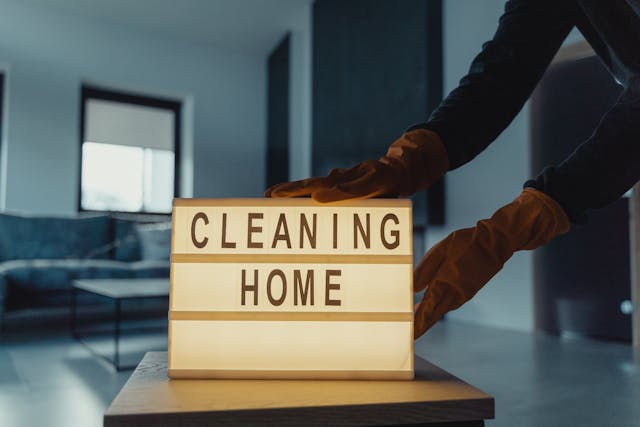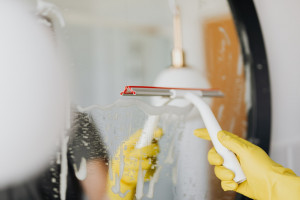- Call Today
- 020 3637 8979
How to Tackle Dust Bunnies: Effective Dusting Techniques

Maintaining Upholstery in Pet-Friendly Homes
April 5, 2024Dust bunnies are small clumps of dust, hair, and debris that accumulate in home corners and under furniture. They are not just unsightly; they can worsen allergies and affect indoor air quality. Handling dust bunnies effectively is important for maintaining a clean and healthy living environment. Simple and efficient dusting techniques can eliminate these pesky particles before they grow and spread. It’s essential to learn these methods to keep your home dust-free and comfortable.
Why Dust Bunnies Form and Where You’ll Find Them
Dust bunnies consist of dust particles, human and pet hair, and tiny debris. These elements combine with static electricity to form clumps. You will typically find them in areas with little foot traffic. Look under beds, behind doors, beneath sofas, and corners of less-frequented rooms. Factors that contribute to their accumulation include low cleaning frequency and inadequate ventilation.
However, homes with pets see more dust bunnies due to shedding fur and dander. High humidity can also cause more particles to stick together, increasing accumulation. Furthermore, keeping these areas clean and improving airflow is key to controlling the spread of dust bunnies. One-off deep cleaning and regular attention to these typical hiding spots can reduce their presence.
What You’ll Need to Defeat Dust
You need the right tools and products to effectively defeat dust and tackle dust bunnies. Essential dusting tools include microfiber cloths, a good vacuum cleaner with a HEPA filter, and a sturdy dustpan and brush. A damp cloth can often do the trick, but you might need a mild detergent for tougher jobs. Those interested in eco-friendly options should consider using reusable dusting cloths and homemade cleaners made from vinegar and water.
Regular maintenance is necessary in the fight against dust. Dust and vacuum at least once a week to prevent dust bunnies from forming. Frequent cleaning also reduces the time and effort needed later to tackle big messes.

Efficient Cleaning while Moving
Organisation and a strategic approach are super important when cleaning. If you are cleaning your place before or while in the process of relocating, make sure you establish and create a moving timeline before starting. It will help you identify and schedule the relocation of items early in the process. This is the best way to clear space for a thorough cleaning and maintain organisation throughout your home.
How to Tackle Dust Bunnies: A Step-by-Step Guide
Start by identifying the common areas where dust accumulates, such as under furniture, along baseboards, and in corners. Use a vacuum with a hose attachment to reach these spots easily. An extendable duster is ideal for hard-to-reach places like the tops of bookshelves and beneath heavy furniture. Make sure to move items like lamps and small appliances to vacuum or wipe underneath them thoroughly. Clean each area systematically to ensure no spot is overlooked.
Robotic vacuums can be helpful in this process, especially for maintaining clean floors under beds and sofas, where dust bunnies frequently gather. Ensure that your robotic vacuum’s filters are clean to maximise efficiency. Target these areas once a week to prevent dust bunnies from forming and growing.

Under and Over: Cleaning Behind and Beneath Furniture
When cleaning behind and beneath large furniture, safely move the pieces. Use furniture sliders under the legs to prevent scratches and ease the movement on hard flooring. Likewise, enlist someone to help with heavier items to avoid injury and damage. Once moved, vacuum thoroughly using a hose attachment to reach deep into the corners and along the walls.
For the areas under furniture, use a flat mop or a long-handled duster to capture dust without needing to move the furniture frequently. Regularly cleaning these often-neglected areas is required, as they can harbour significant amounts of dust and allergens that affect indoor air quality. Prioritising these spots during your cleaning routine ensures more comprehensive cleanliness and helps maintain a healthier living environment.
Strategic Sweeping: Techniques for Floors and Carpets
To sweep floors and carpets effectively, start by choosing the right tool. For cleaning hardwood floors and tile, use a microfiber cloth attached to a mop. For carpets, a vacuum cleaner with a brush attachment works best. Begin sweeping from one corner of the room and move systematically toward the door to avoid stepping on cleaned areas. Use microfiber cloths and static dusters to capture fine dust particles.
These tools attract dust through static electricity, making them highly efficient. To maintain these tools, wash microfiber cloths regularly in warm water and let them air dry. Fabric softeners should be avoided as they can reduce their static properties. For static dusters, shake them out after each use and wash gently by hand if needed. Regular maintenance ensures these tools remain effective and extend their life.
After the Hunt: Disposing of Dust Safely
After collecting dust and dirt, disposing of it safely is key to maintaining a clean home environment. First, always empty the vacuum bag or canister directly into a garbage bag to minimize dust escaping back into the air. Seal the bag immediately to trap the dust. For eco-friendly disposal, consider using biodegradable bags.
It’s important to understand the environmental impact of certain disposal methods. Burning dust or throwing it outside can release pollutants and contribute to land contamination. Instead, always use trash disposal services to handle your dust waste properly. Additionally, dampen your cloth slightly when wiping surfaces to prevent dust from scattering during cleaning. This method ensures dust adheres to the cloth instead of becoming airborne again.

Daily Habits to Adopt: Maintaining a Dust-Free Environment
- Start by dusting surfaces with a microfiber cloth each morning; it traps more dust than ordinary dusters.
- Vacuum high-traffic areas daily to prevent dust accumulation.
- Make it a routine to shake out rugs and mats outside.
- Keep windows closed on windy days to minimize outdoor dust entering your home.
- Invest in an air purifier, as it helps effectively capture airborne dust particles.
- The benefits of using aromatherapy in cleaning can also enhance the experience by providing a calming scent and additional antibacterial properties.
These simple yet effective habits can significantly reduce dust in your home, making it a healthier space for everyone. Consistency is key to seeing lasting results.
Embrace a Clean Home: Key Takeaways for Dust-Free Living
In this guide, we’ve explored effective methods on how to tackle dust bunnies, from preparation and strategic cleaning to proper disposal. Maintaining a dust-free home is straightforward with the right tools and regular habits. The benefits include improved air quality and a healthier living environment. Stay diligent with your cleaning routine, and you’ll consistently enjoy the comfort of a clean home. Keep pushing forward, and don’t let the dust settle!


